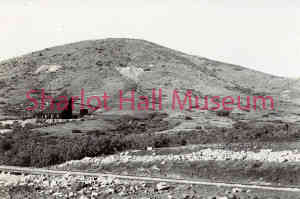Henrietta Mines
details
Unknown Unknown 1600.0226.0001.jpg M - 226 B&W 1600-0226-0001 m226p Print 5x7 Historic Photographs 1890s Reproduction requires permission. Digital images property of SHM Library & ArchivesDescription
Henrietta Mines, Big Bug District, Yavapai County, Arizona Territory, c. 1890.
The Big Bug mining district was sixteen miles southeast of the town of Prescott, in Yavapai County, Arizona Territory. It was situated in the Bradshaw Mountains, the highest peaks of which were Mount Union and Mount Davidson at over 9000 feet above sea level. The Big Bug Mine, after which the district was named, was north of the town of Mayer, near Poland Junction. It was one of the earliest rich lode mines discovered in the area. It was later called the Henrietta Mine, and was staked by a pioneer miner in the district, Theodore W. Boggs.
The mine was located at an elevation of 5,200 feet above sea level and its' main commodity was gold.
In its' early years, 1866, the Big Bug/Henrietta mine was some 50 feet deep and produced ore from near the surface. In 1871, the Big Bug vein itself was not being worked, but the its' 10-stamp mill was treating gold ores from the surrounding vicinity. At that time, the combined costs of mining and milling amounted to about $9 per ton.
The following text from Arizona Lode Gold Mines and Gold Mining, Arizona Bureau of Mines, original 1934, revised 1967, best describes the nature and production of this mine: In 1883 and 1884, the Big Bug property was the most prominent one in the district. During this early period, the mine made a large production mainly from the oxidized gold ores from the upper levels. From 1915 to 1919, the mine was operated by the Big Ledge Copper Company which did considerable development below the old workings and produced gold-bearing copper ore. The property was equipped with a 100-ton flotation mill. In 1923, this company was reorganized as the Huron Copper Mining Company. Some shipments of copper ore containing gold were made in 1926 and 1930.
A longitudinal section of the workings is shown in U. S. Geol. Survey Bulletin 782. The old developments, which extended to the sulphide zone, include a 500-foot shaft, on the ridge, with a 1,500-foot tunnel through the ridge, 220 feet below the collar, and considerable stoping. Farther north, on the Gopher claim, the vein has been opened to depths of a few hundred feet. The deeper work, which was done by the Big Ledge Copper Company, included a 2,200-foot tunnel and a 600-foot winze with levels and stopes extending a few hundred feet northward.
The vein, which occurs mainly in massive, fine-grained amphibolite or diorite, strikes north, dips about 70° W., and is from 2 to 6 feet wide. Its gangue consists of massive quartz with some calcite. About 60 per cent of the unoxidized ore consists of pyrite, chalcopyrite, sphalerite, and galena. Ore from the lower levels is reported to contain 3.2 per cent of copper and 14 per cent of iron, together with 0.2 ounces of gold and 2.7 ounces of silver per ton.
Purchase
To purchase this image please click on the NOTIFY US button and we will contact you with details
The process for online purchase of usage rights to this digital image is under development. To order this image, CLICK HERE to send an email request for details. Refer to the ‘Usage Terms & Conditions’ page for specific information. A signed “Permission for Use” contract must be completed and returned. Written permission from Sharlot Hall Museum is required to publish, display, or reproduce in any form whatsoever, including all types of electronic media including, but not limited to online sources, websites, Facebook Twitter, or eBooks. Digital files of images, text, sound or audio/visual recordings, or moving images remain the property of Sharlot Hall Museum, and may not be copied, modified, redistributed, resold nor deposited with another institution. Sharlot Hall Museum reserves the right to refuse reproduction of any of its materials, and to impose such conditions as it may deem appropriate. For certain scenarios, the price for personal usage of the digital content is minimal; CLICK HERE to download the specific form for personal usage. For additional information, contact the Museum Library & Archives at 928-445-3122 ext. 14 or email: orderdesk@sharlot.org.




